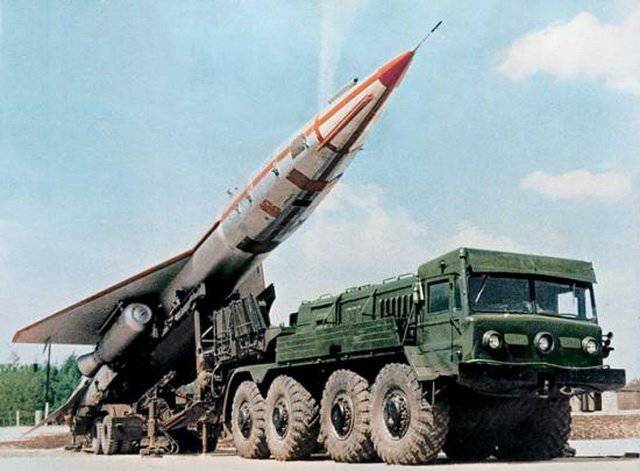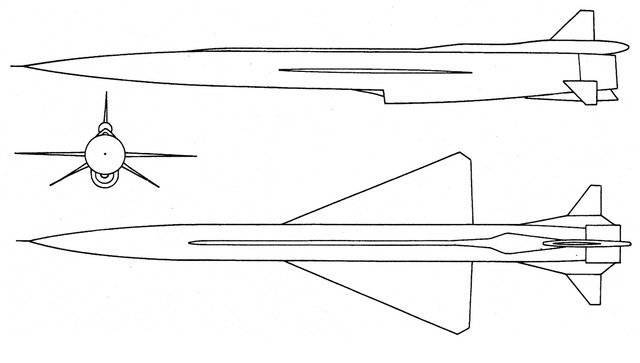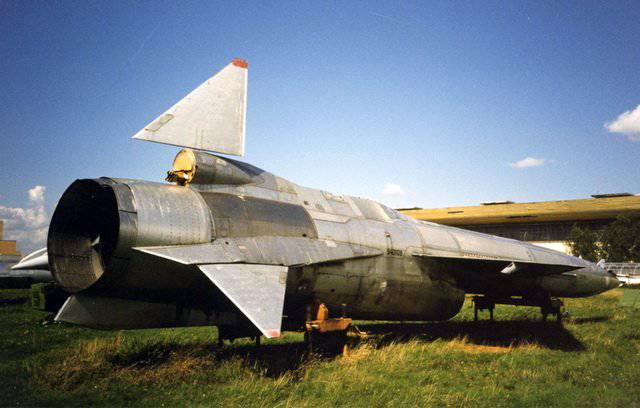Soviet drone - Tu-123 "Hawk"

At the end of 1950-s, due to the growing threat of a possible nuclear strike from the US, the leadership of the USSR made a decision to develop a long-range unmanned photo and radio intelligence system, which was called the Hawk. The Tupolev Design Bureau was assigned to be responsible for solving this task, which already had experience in creating the Tu-121 unmanned assault aircraft. Soon, the EDB was created supersonic long-range unmanned reconnaissance (UAV), which received the designation Tu-123 "Hawk", another designation of the machine was DRB-1 - the first unmanned reconnaissance scout. Its main purpose was to conduct photo and radio intelligence at a distance of more than 3 000 km.
Creation of Tu-121 and Tu-123 Yastreb aircraft at the Tupolev Design Bureau laid the foundation for the aerodynamic calculations of UAVs in the USSR, taking into account the specifics of designing and manufacturing onboard equipment, the laws of automatic control and, above all, control and navigation systems. Were laid technology production and testing in the production of UAVs, their refinement and testing. In close cooperation with the research institutes of the Air Force, enormous work was carried out and the ideology of combat use and technical maintenance of this kind of systems in military units was determined.
The long-range unmanned reconnaissance system was intended to conduct aerial reconnaissance of airfields, missile positions, naval bases and ports, military-industrial facilities, ship connections, missile defense and air defense systems, as well as monitoring the results of the use weapons mass destruction (chemical and nuclear). Photo reconnaissance was carried out by photographing large areas and extensive routes with general and detailed reconnaissance aerial cameras.
Radio reconnaissance was carried out by recording signals from enemy radio equipment that worked in the flight zone of the reconnaissance aircraft. The recorded radio signals made it possible to determine the location and type of the deployed enemy radio equipment. Tu-123 “Yastreb” allowed to produce: photo-exploration of a route or a strip of terrain with a width of 60-80 km. and up to 2 700 km. in scale 1 km. in 1, see, as well as stripes in width in 40 km. and up to 1 400 km in length when using the 200 scale in m. 1, see. Radiotechnical reconnaissance was carried out with a side-view depth of up to 300 km.
By design, the Tu-123 “Hawk” UAV corresponded to the Tu-121 strike aircraft previously created, the main difference was in the deployment of reconnaissance equipment. This equipment, along with a number of elements of the navigation and aerobatic complex, was placed in the nose of the aircraft with a total weight of 2 tons. This part was returned and landed on the ground with a parachute. The nose part was equipped with a special chassis of a simplified design, which was released in the air just before landing. The rest of the design of the Tu-123 after the execution of the assigned reconnaissance mission died.
Compartments with installed reconnaissance photoelectric equipment created a kind of “photo studio” that had glazing from heat-resistant glass, equipped with a special blowing system. This system prevented the formation of the so-called “haze” effect in the space between the panes and the camera lenses. Above the engine nozzle was a container in which there was a braking parachute used to dampen the airspeed before disconnecting the nose compartment with the equipment installed in it.

The “Hawk” control system operated autonomously according to a predetermined program. The withdrawal of the scout to the place of the landing of the part with the reconnaissance equipment was carried out with the help of a driving radio system. The UAV was preparing for the flight at the launch position, which included the CTA-30 launch vehicle, which was developed on the basis of the MAZ-537 rocket tractor with a semi-trailer - the launch vehicle and the CARDS-1 control and launch vehicle. In the back of the CARDS-1 was testing equipment. Immediately before launching, a flight program was introduced into the control system of “Yastreb”. UAV Tu-123 started from an inclined ramp. The launch, derailment of the device from the launcher and acceleration to the required initial speed were performed using the launch solid accelerators PRD-52, which have a load at the level of 80 000 kgf. each. Both accelerators stopped working on the 5 second flight, after which they were separated from the fuselage of the UAV.
The Tu-123 “Hawk” march was provided by the KR-15-300 engine, which for 9 seconds operated afterburner with 15 000 kgf., After which the air intake manifold was shot and the engine was converted into cruising mode with maximum 10 000 kgf. In flight, the onboard cameras turned on and off on command. After completing the mission, the unmanned reconnaissance aircraft was programmatically deployed in the opposite direction and at a distance of 400-500 km. from the base there was an automatic activation of the onboard drive equipment.
After the aircraft was identified by ground means, the vehicle was monitored and the UAV issued the commands necessary to bring it to a given landing point of the salvaged compartment with reconnaissance equipment. According to the program, the TRD was turned off and the remaining fuel was drained, after which the device was switched to the climb mode for damping speed and the deceleration parachute was released. After this, the reconnaissance compartment was separated and descended to the ground.
The serial production of the UAV Tu-123 “Hawk”, as well as other elements of the complex, was carried out in Voronezh until the 1972 year, until that time the 52 UAV was released. The flights of the Tu-123 “Yastreb” in order to maintain the practical skills of the specialists of the BSR units and checks were usually carried out only at fairly large Soviet test sites (Far East, Transbaikalia, Central Asia). Flight routes were laid over sparsely populated areas of the USSR. If, due to the failure of the onboard equipment, the drone had bowed out of a given route with a tendency to go beyond the landfill, it was eliminated: a command was sent from the ground that turned off the engine and transferred the UAV into a dive with a deep roll.

The DBR-1 system was in service with the intelligence units of the USSR Air Force, which were deployed in the western border military districts, up to the 1979 year. The Tu-123 “Yastreb”, starting from the territory of the USSR, could successfully conduct reconnaissance of practically the entire territory of Western Europe. The operation of the complex in the USSR was repeatedly verified by a large number of launch sites in the framework of the Air Force exercises. But in spite of this, the “Hawk” never fulfilled reconnaissance of real targets in the territory of NATO member countries.
After the adoption of the MiG-25R supersonic reconnaissance aircraft in 1972, the DBR-1 complexes began to be gradually withdrawn from service, and their elements were disposed of. Part drones The Tu-123 was transferred to the Air Force training grounds to create targets (the UAV data imitated the American Pershing missiles). The currently preserved copy of the Tu-123 "Hawk" is presented at the exhibition aviation equipment located at the Central Airport. M.V. Frunze in Moscow.
Based on the Tu-123 UAV, several different modifications of the original project were created:
- the manned version of the Tu-123P (Yastreb-P), the returned reconnaissance aircraft with the pilot on board, a draft was prepared;
- UAV Tu-139 (Hawk 2) - a fully rescued version of the Tu-123, several prototypes were built;
- unmanned target aircraft Tu-123M (Hawk-M), was prepared by an experienced specimen;
- project of a Tu-123 UAV with ramjet designed for flight at speeds corresponding to M = 3-4;
- project of a Tu-123 drone with a nuclear power plant;
- The project of the use of drone Tu-121 or Tu-123 as the last step in the shock planning system "DP".
Flight specifications Tu-123 "Hawk":
Dimensions: wingspan - 8,41 m., Length - 27,83 m., Height - 4,78 m.
Empty mass - 11 450 kg., Maximum take-off - 35 610 kg.
Fuel stock - 16 600 l.
Engine type - 1 TRDF P-15K-300, unforced traction - 10 000 kgf.
Accelerators - 2 PRD PRD-52, 2х80000 kgf.
The maximum speed is 2 700 km / h.
Practical range - 3560-3580 km.
The flight altitude at the beginning of the march is 22 800 m., At the end of the march is 19 000 meters.
Information sources:
-http: //www.airwar.ru/enc/spy/tu123.html
-http: //www.testpilots.ru/tp/russia/tupolev/123/123.htm
-http: //www.dogswar.ru/oryjeinaia-ekzotika/aviaciia/6004-razvedyvatelnyi-bpla.html
http://ru.wikipedia.org
Information